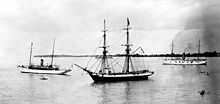Snow (ship)
In sailing, a snow, snaw or snauw is a square rigged vessel with two masts, complemented by a snow- or trysail-mast stepped immediately abaft (behind) the main mast.[1]
| Snow | |
|---|---|
|
Schematic view of Snow, showing the snow-mast, a loose footed gaff sail and clewed up main course. | |
| Type | Sailing rig |
| Place of origin | Northern Europe |
History
The word 'snow' comes from 'snauw' which is an old Dutch word for beak; a reference to the characteristic sharp bow of the vessel.[2] The snow evolved from the (three-masted) ship: the mizzen mast of a ship was gradually moved closer towards the mainmast, until the mizzen mast was no longer a separate mast, but was instead made fast at the main mast top. As such, in the 17th century the snow used to be sometimes classified as a three-masted vessel.[3]
The snow dates back to the late 17th century and originally had a loose footed gaff sail, the boom was introduced somewhere in the 18th century. It was a popular type of vessel in the Baltic Sea and was employed by a large number of nations during its time. The snow was considered a handy and fast sailing vessel, typically the largest two masted vessel around and was employed in both navy and merchant service.[4] When used as a military vessel, snows were, in the early 18th century, typically fitted with 5 to 16 guns. Military snows were mostly used for coastal patrols and privateering, while in the merchant service, snows traded all the way to the Mediterranean and sometimes even sailed as far as the West Indies.

Snow: the largest of all old two-masted vessels. The sails and rigging on the main mast of a snow are exactly similar to those on the same masts in a full-rigged ship; only that there is a small mast behind the mainmast of the former, which carries a sail nearly resembling the mizzen of a ship.
Difference with brig
Although the snow and the brig appear to be very similar, the two rigs have very different origins. The brig evolved from the generally smaller brigantine and the much older snow evolving from the larger three masted ship.[6]
The most visible difference between the brig and the snow is in the snow-mast stepped directly behind the main mast.[7] On a brig, the gaff and boom are attached directly to the main mast, but in a snow the gaff (and later the boom as well) were attached to the snow-mast. The use of this characteristic snow mast offered several advantages.[8]
The yoke (or jaw) of the gaff and the lacing of the gaff sail on a snow could move freely on the snow mast, not hindered by the iron bands that held together the (main) mast, nor limited by the main yard. As a result, the gaff could be raised higher than the main yard and independently of it. The resulting freedom allowed a snow to fly a main course, as they typically did. Brigs could not easy accomplish this particular sail arrangement. [9]
Nonetheless, by the late 18th century, brigs started to set main courses as well, and this gave rise to the term "snow-brig." The difference between snows and brigs was lessened even further when the snow-mast was replaced by a steel cable. In time, the term snow-brig became interchangeable with the term brig and the term snow fell in disuse.

The twin brigs Lawrence and Niagara, American warships of the Battle of Lake Erie, were both snow-brigs.
See also
Notes
- ↑ Hans Haalmeijer (2009). Pinassen, fluiten en galjassen, the Netherlands: Uitgeverij De Alk B.V.
- ↑ Hans Haalmeijer (2009). Pinassen, fluiten en galjassen, the Netherlands: Uitgeverij De Alk B.V.
- ↑ Dik Vuik, Hans Haalmeijer (2006). Aken, tjalken en kraken. Alkmaar, the Netherlands: Uitgeverij De Alk B.V.
- ↑ http://www.vaartips.nl/zeevaart.htm#snauw
- ↑ Defoe, Daniel (1999) [First published 1724]. "The Introduction". In Schonhorn, Manuel. A General History of the Pyrates. Dover: Dover Publications. p. xlviii. ISBN 0-486-40488-9. Retrieved 19 June 2011.
- ↑ Hans Haalmeijer (2009). Pinassen, fluiten en galjassen, the Netherlands: Uitgeverij De Alk B.V.
- ↑ http://en.academic.ru/dic.nsf/cide/163048/Snow
- ↑ http://modelshipworld.com/index.php/topic/5958-question-on-the-rigging-of-the-mainsail-of-a-brigantine/
- ↑ Dik Vuik, Hans Haalmeijer (2006). Aken, tjalken en kraken. Alkmaar, the Netherlands: Uitgeverij De Alk B.V.
References
- Hans Haalmeijer: Pinassen, fluiten en galjassen Uitgeverij De Alk B.V., Alkmaar, the Netherlands 2009.
- Karl Heinz Marquardt: Bemastung und Takelung von Schiffen des 18. Jahrhunderts. Weltbild Verlag, Augsburg 1994.
- John Robinson, George Francis Dow: The Sailing Ships of New England 1607 - 1907. Marine Research Society, Salem, Mass 1922.
- Dik Vuik, Hans Haalmeijer: Aken, tjalken en kraken, Uitgeverij De Alk B.V., Alkmaar, the Netherlands 2006.
External links
-
 The dictionary definition of snow at Wiktionary
The dictionary definition of snow at Wiktionary - The Mystery Snow Brig, a magnificintly preserved wreck in the Baltic Sea
- Model of a Snow, collection Dutch National Maritime Museum, Amsterdam
- Model of a snauwschip (1780), collection Dutch State Museum, Amsterdam
| ||||||||||||||||||||||||||||||||||||||||||||||||||||||||||||
